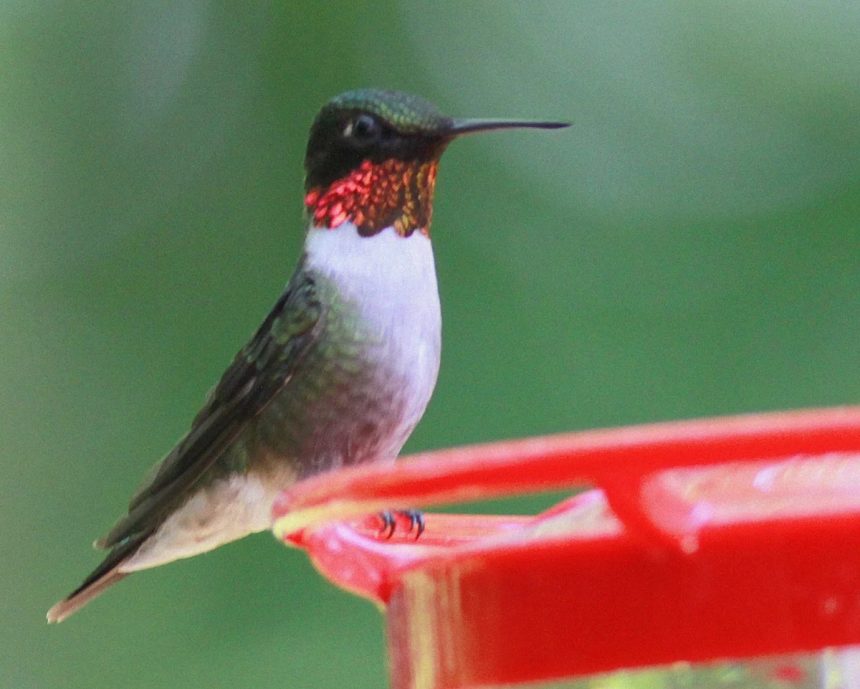One of the many signs of fall, aside from the chilling temperatures and the changing colors of the leaves, is the departure of New Jersey’s beloved hummingbirds as they begin their annual migration to warmer climates.
If you happen to spot one in New Jersey, you are most likely looking at the ruby-throated hummingbird. According to New Jersey Fish and Wildlife, this species is the most common hummingbird in North America seen east of the Mississippi River.
Ruby-throated hummingbirds are one of the smallest migrating birds, coming in at 3 to 3.5 inches in length. They beat their wings more than 50 times a second, creating a humming sound that gives them their name.
While they are commonly spotted during the spring and summer, it is around this time of year that hummingbirds begin to leave the Garden State, heading south to spend the cold winter months in Florida and Central America.
Here’s everything you need to know about hummingbirds, and how to track them, as they embark on their annual fall migration.
When do hummingbirds leave New Jersey?
Ruby-throated hummingbirds are early migratory birds, according to the Rutgers New Jersey Agricultural Experiment Station. They typically leave their northern breeding grounds in late July through early September to overwinter in Florida and Central America.
Various factors trigger their fall migration. Per Hummingbird Central, it is generally thought that hummingbirds sense changes in daylight duration and declining numbers of flowers, nectars and insects. Their internal biological calendar and cooling weather conditions also play a role.
Where do hummingbirds go during the winter?
Ruby-throated hummingbirds typically spend the winter in Florida and Central America, according to Rutgers experts.
In September and October, according to Hummingbird Central, ruby-throats gather in Florida, Louisiana and along the South Texas coast in preparation for the final push to the south, either over the Gulf of Mexico, renamed by the U.S. government as Gulf of America, or via an overland route through Mexico and as far south as northern Panama.
Their preferred habitats during the winter months include tropical deciduous and dry forests, second-growth scrub, pastures, and edge habitats where they lead solitary lives, relying on consistent food sources such as nectar and insects.
When will hummingbirds return to New Jersey?
In early spring, individuals will begin to leave the wintering grounds, arriving in New Jersey in mid-April to stake out territories and begin a new breeding season.
Although they are small, hummingbirds are powerful flyers. Per Rutgers, they are capable of crossing 500 miles over the Gulf in a single non-stop flight lasting 20 hours.
They fly alone, often on the same path they have flown their whole life, according to Hummingbird Central. Young hummingbirds must navigate the journey without parental guidance or previous flight experience.
Track hummingbird migration and report your sightings
To track hummingbirds as they make their journey south, check out Hummingbird Central’s 2025 Hummingbird Fall Migration Map. Report your sightings to Hummingbird Central to contribute to this year’s map.
Hummingbird species found in New Jersey
Seven species of hummingbird can be found in New Jersey, including:
-
Ruby-throated hummingbird
-
Black-chinned hummingbird
How to spot a ruby-throated hummingbird
These tiny birds are metallic green on top with whitish-gray underparts and wings that are almost black, according to NJ Fish and Wildlife. They have long narrow beaks that they use to sip nectar from flowers.
Males have a ruby red patch on their throat with a black upper rim. Their tail is forked and black with a slight violet sheen.
It’s fall!: Here are some of the best places to go apple picking in NJ this fall
Females have notched tails with green, black, and white edges. A female ruby-throated hummingbird will have a white throat, not a red one, with potential streaks of gray.
Their nests are tiny and can be found on downward sloping branches. They typically build nests between 10 and 40 feet above the ground, according to the Rutgers NJ Agricultural Experiment Station.
Will feeders prevent hummingbirds from migrating?
Despite popular belief, leaving artificial nectar feeders outside will not prevent hummingbirds from migrating. According to Rutgers experts, any hummingbirds spotted at feeders during the winter are likely vagrant western species, such as the Rufous hummingbird.
If you are interested in attracting and helping hummingbirds as they finish their journey back up north this coming spring, you can put out feeders and plant flowers in your yard.
While native flowering plants are the best source of nectar for hummingbirds, supplementing with a well-tended sugar-water feeder can provide additional sustenance during nesting season and migration, according to the National Audubon Society.
For feeding tips and answers to commonly asked questions, check out the Audubon website at https://www.audubon.org/magazine/hummingbird-feeding-faqs.
This article originally appeared on NorthJersey.com: New Jersey Hummingbird fall migration 2025 map: Are they still here?








